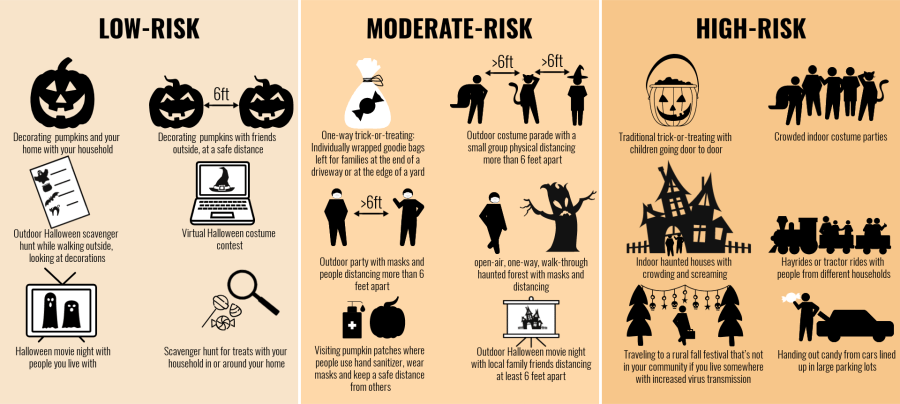With Halloween on the way and the coronavirus still widespread, the U.S. Centers for Disease Control and Prevention this week released guidelines for safely celebrating the spooky holiday.
Traditional trick-or-treating, crowded parties and indoor haunted houses are among the activities the CDC says pose the highest risk for coronavirus transmission and families should avoid them this year.
And with face masks required to curb the spread of the virus, officials urge that people not wear costume masks over their face coverings if the costume makes it hard to breathe.
“Many traditional Halloween activities can be high-risk for spreading viruses,” the CDC said. “There are several safer, alternative ways to participate in Halloween.”
But those who have the virus, know they were exposed to it, or have COVID-19 symptoms should not host or participate in any in-person festivities, officials said. People at risk for severe illness were also told to avoid any in-person gatherings.
The CDC on Monday ranked halloween activities based on the risk they pose of spreading the coronavirus.
“These considerations are meant to supplement—not replace—any state, local, territorial, or tribal health and safety laws, rules, and regulations with which holiday gatherings must comply,” the CDC says. “When planning to host a holiday celebration, you should assess current COVID-19 levels in your community to determine whether to postpone, cancel, or limit the number of attendees.”

In general, wearing masks, practicing physical distancing, hand-washing, disinfecting surfaces, limiting contact and wearing masks when preparing food is required. Hosting small gatherings outdoors for shorter periods of time is safer than large indoor parties, according to health officials.
Here’s how the CDC ranks Halloween activities:
Lower risk activities:
- Carving or decorating pumpkins with members of your household and displaying them
- Carving or decorating pumpkins outside, at a safe distance, with neighbors or friends
- Decorating your home
- Having a Halloween scavenger hunt where children are given lists of Halloween-themed items to look for while walking outside and looking at Halloween decorations from a distance
- Having a virtual Halloween costume contest
- Having a Halloween movie night with people you live with
- Having a scavenger hunt for treats with your household members in or around your home
Moderate risk activities:
- Participating in one-way trick-or-treating where individually wrapped goodie bags are lined up for families to pick up while practicing physical distancing. (The person preparing the bags should wash their hands with soap and water for at least 20 seconds)
- Having an outdoor, open-air costume parade with a small group of people who are distanced more than 6 feet apart
- Attending an outdoor costume party where everyone wears protective masks and people can stay more than 6 feet apart. (Costume masks can’t be a substitute for a cloth mask.)
- An open-air, one-way, walk-through haunted forest where masks are required and people can keep more than 6 feet apart. (If there will be screaming, greater distancing is advised.)
- Pumpkin patches or orchards where people wear masks and use hand sanitizer before touching pumpkins or picking apples and maintain social distancing
- An outdoor Halloween movie night with local family friends spaced at least 6 feet apart. (Or a greater distance if there will be screaming)
Higher risk activities that should be avoided:
- Participating in traditional trick-or-treating where treats are handed to children going door to door
- Attending crowded indoor costume parties
- Having “trunk-or-treat” where candy is handed out to kids from trunks of cars lined up in large parking lots
- Going to indoor haunted houses where people are crowding together and screaming
- Going on hayrides or tractor rides with people who from different households
- Traveling to a rural fall festival in another community if you live somewhere with increased COVID-19 transmission
- Drinking alcohol or doing drugs, “which can cloud judgement and increase risky behaviors.”
People who end up participating in high-risk activities should stay home as much as possible for the 14 days that follow, avoid people at risk of severe illness from COVID-19 and consider getting tested, officials said.
If after attending a Halloween event, you find out you were exposed to someone with the virus, stay home for two weeks, monitor yourself for symptoms and get tested if you feel sick.
More information can be found on the CDC’s website.












